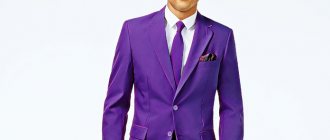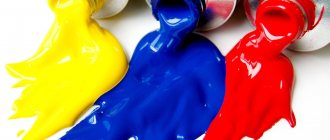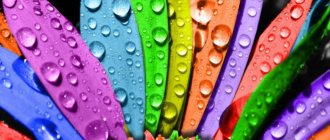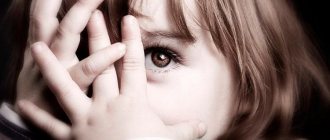We study the influence of color on children.
Surely you have noticed that if a child likes a certain color, he chooses it in everything. Clothes, toys, accessories, and even balloons or ice cream should be your favorite color. And nothing can be done - this is the period.
In fact, children are instinctively drawn to those colors that are most pleasant and useful to them at a given stage of development. Scientists have proven that colors have the ability to have a powerful effect on the psyche. This is especially true for children, because a child’s visual perception helps him understand the world. Color can bypass the “obstacle” of our consciousness and act on an unconscious level. This property is used in alternative medicine - color therapy.
Yellow color in the drawings of a preschool child: meaning in psychology
The color yellow in children's drawings symbolizes the color of the sun. It is no coincidence that the sun usually smiles in children’s pictures. Mom and the sun are equally important for children. Such pictures may indicate that the love and care of their mother is very important to children.
Children's drawing about mother and the sun
Attentive parents can determine the child’s emotional state from the baby’s drawings. Not being able to express his thoughts and feelings in words, a child is able to express them with drawings. The more bright colors they contain, the more positive emotions your baby will experience.
Drawings of children experiencing positive emotions
When drawing this picture, the kid used all the colors of the rainbow except black. The colorful caterpillar is smiling, the sun is shining, and the flowers are blooming. This is how a healthy baby can think, in whose life there is no reason to be upset.
Impact on the psyche
Color truly is a powerful tool for influencing the human psyche. Explaining the meaning of different shades is the path to the secret of revealing the personality of the subject. It’s not for nothing that we prefer clothes made in one color or another. We use a notepad of a certain shade, purchase a unique smartphone and, again, decorate it to our own taste. The color green may well dominate; the psychology of color reveals not only personality traits in general terms. This can be done depending on the predominant shade (light or dark).
In fact, each color tends to influence the psyche in a certain way. The shade can lift or worsen your mood, increase or, conversely, decrease your strength. Marketers are perfectly aware of how colors affect the mind. In order to correctly use the qualities of your favorite color in everyday life, you should learn about how it affects the psyche. Because you can consciously surround yourself with a certain color, counting on changes in character.
Red color in the drawings of a preschool child: meaning in psychology
Red color is a frequent guest in children's drawings; it is flashy, bright and instantly attracts attention.
Red car in a child's drawing
Do children and adults perceive the color red the same? For adults, this color is associated with aggression and pathos. Perhaps this is the influence of Christian morality, which calls for meekness and dull clothing, or fatigue from bright information advertising that bombards us from TV screens and billboards. Red color warns of danger from road signs.
How do adults perceive the color red?
However, for the pure consciousness of a child, the meaning of red is somewhat different. Red is the color of strength, enthusiasm and struggle to move forward. Primitive peoples believed that the color red can carry both positive and negative messages, but it always symbolizes strength.
Red dragon in a child's drawing
Properties
Orange has extremely warm shades. This explains its positive psychotherapeutic influence .
It correlates with positive thinking, so if you need to get out of depression, this color is one of the best helpers.
Too much of it can be annoying. Neon orange is especially tiring, so its use should be measured.
Orange color in the drawings of a preschooler: meaning in psychology
Children rarely choose one color for their drawings. Almost every child’s drawing is drawn with multi-colored pencils, and if you notice that your child chooses only one pencil to draw, maybe you shouldn’t panic and re-read mountains of materials on psychology, finding out what this means?
Maybe the worries are in vain?
Take a closer look at the pencils your baby uses to draw. Perhaps one of the pencils is sharper than the others and is easier to draw with? It also happens that in one box there are soft and hard pencils, which are more difficult to draw with. A hard pencil needs to be pressed harder, which means the child will choose a soft one.
Is your baby comfortable drawing?
Orange color is not inferior to red in brightness. This is the color of the rising sun. It catches the eye if flowers or toys are painted with it. By choosing this color for his drawings, the child strives for leadership. This also manifests itself in drawing. If your child's drawing is brighter than the drawings of other children, it means that your baby has the ability and desire to be better than his friends.
Flying animals in a children's drawing
The effect of color on health
And what is important, under the influence of green color, the regeneration of body cells is accelerated. This color relieves negative emotions and also eliminates irritation, stimulates the functioning of the cardiovascular and reproductive systems, and the activity of the pituitary gland. At the same time, the color helps lower blood pressure.
Interestingly, if a person sees insufficient amounts of green, his performance decreases. You also lose faith in your own strengths, and nervous exhaustion may occur. All this happens at the same time that the individual doubts many of his decisions.
Purple color in the drawings of a preschool child: meaning in psychology
Psychologists believe that the color purple can evoke sadness and sadness. It is rarely chosen for interior decoration, clothing and furniture. Should you be upset if you notice that your child is constantly drawing with a purple pencil? The color purple comes in many shades and some shades are as vibrant as red or yellow.
All shades of purple
You can’t do without purple if you need to paint an autumn sky or a stormy sea. Some flowers have purple petals, and if your child uses purple pencils for such drawings, nothing bad will happen to him.
Spring landscape. The forest is painted with purple colors
Who can I recommend using?
there is a lack of positivity in your life and your vitality is low, then orange will add color, warmth and good mood.
If you are depressed, wear orange clothes, buy oranges, add orange to your interior in the form of beautiful pillows, bedspreads or indoor plants.
In clothes
Stylish orange is great for summer . Not only ladies, but also men can use it. At the resort, this color will add color and create the mood for relaxation.
You can wear an orange dress, pants or shorts, or add accessories in the form of bright bracelets, amber beads, and hair ribbons.
In clothes it is combined with white. Speaks of openness, ease, and willingness to make contact.
The combination with black is interesting ; orange smoothes out the gloomy effect of the latter. These two colors create a feeling of nobility, elitism, and celebration.
Orange next to brown creates a calm, cozy look.
The combination of warm orange and blue is interesting. These two colors complement and shade each other, creating harmony .
Cool purple creates an unusual ensemble with warm orange.
The colors complement and shade each other . Against the background of purple it looks brighter and more saturated.
Such combinations are also natural for nature, for example, violets or pansies.
Pink and orange are unusual, romantic , but it is difficult to choose the right shades so that they look harmonious.
Goes well with green - the colors of summer, youth, life.
It will dilute the too bright orange gray color. It will give clothes calmness, smooth out aggressiveness and richness.
Rules for combining orange in clothes:
What does sanguine mean? Read about it here.
In the interior
Orange is suitable for kitchen decoration . Use it to line cabinets. Brightly colored wallpaper with fruit patterns looks interesting in the dining area. Orange increases appetite and promotes good digestion.
Orange-colored bedspreads look stylish in the living room
Curtains of pale orange color are suitable for the recreation area.
Frameless chairs of this color will also find their use in the recreation area. Shades of orange fit perfectly into country, eclectic, and oriental styles.
Ideas for using orange in the interior:
Blue color in the drawings of a preschool child: meaning in psychology
Blue is the color of winter and snow in children's drawings. It is also the color of the sea and sky. If a child draws a winter picture or the sky with a blue pencil, there is nothing strange or scary about it.
Children paint winter with blue paints
It happens that children paint animals and fairy-tale characters blue. Such drawings may indicate that the baby has very developed fantasy thinking. Such children see ordinary objects and animals as wonderful heroes of their dreams and fantasies.
Blue cat painted with watercolors
What can you say about a person who likes orange?
Those who prefer orange have optimistic character.
They emanate maximum positive energy, these people are the sun - warm, good-natured, active and joyfully looking at the world.
They have many talents, strive for development, cannot sit in one place for a long time, they constantly need to move, learn, and communicate. Their character charges other people with positivity .
Orange lovers achieve everything through their own efforts. Such people strive for happiness and success. They believe in themselves, are endowed with ambition and perseverance.
Lovers of this color may also exhibit the following character flaws: excessive impulsiveness, a tendency to change feelings, pretense, self-deception and spoiling.
Is it possible to determine a person's character by their handwriting? Find out about this from our article.
Green color in the drawings of a preschool child: meaning in psychology
Green is the color of grass and trees. Children love to draw flowers, leaves and grass. But, if you notice that your baby often draws such pictures, then perhaps he feels a lack of love on your part. Going into the fabulous world of plants, he fills the vacuum of warmth and parental care.
Children's drawing about summer
Children who draw plants are sensitive to injustice towards them. They, like a barometer, react to an unfavorable microclimate in the family. They are vulnerable and shy.
What does the color green mean in children's drawings?
Luscher test
Color perception has been studied by many psychologists. But a significant contribution in this direction was made by Dr. Max Luscher. He was interested in how color affected the psychophysiological state of patients.
During the research, the doctor came to the conclusion that a person makes an unconscious choice of color. To check the patient's perception, he is given a simple test. You need to choose the color you like from those offered. The patient must simply show a shade that is pleasant to him. The answer should not be associated with objects, memories, or logical considerations. You need to choose one of the colors for as long as possible until the proposed set changes.
In fact, the decision made may be related to the patient’s internal state at a given time, as well as to his work activity. And after the test is passed, all that remains is to look at the results. They are presented in the form of quite interesting and detailed analysis. If a person chooses green, color psychology allows us to learn about his character.
Black color in the drawings of a preschool child: meaning in psychology (give a link to the article)
Black is the saddest of all possible colors. Should you panic if your children's drawings are black and white? Sometimes children choose this style of drawing only because it is easier and easier to convey the shape of drawn objects, animals and people. Only those drawings in which there is expressed aggression or resentment towards the world around us should be wary. Psychologists believe that this color can be chosen by a child in a depressed emotional state.
Sad child's drawing
In such cases, parents need to try to understand the reasons for their children's depressed mood. Sometimes, with their drawings, children themselves give clues to their parents.
Drawing calling for help
If children draw scary, from the parents’ point of view, pictures with a black pencil, the parents have a question: is everything okay with the baby’s health? Before turning to psychotherapists for help, determine whether your child sees your fear and confusion when you look at these pictures? The fact is that children can read your inner feelings by the expression on your face. And if the baby liked your scare, he may deliberately continue to draw such pictures in order to scare his parents.
Black and white children's drawings
Usually, parents turn to the help of psychotherapists when they themselves feel helpless in solving problems with raising their child. Thus, they shift their work of raising children onto the shoulders of other people.
VIDEO: Psychologist’s work in kindergarten
How to determine a child’s emotional mood at home?
Ask your child to draw an elephant. If a child draws it with a black and gray pencil, it means he is in a sad mood today.
Gray elephant
If the elephant turns out to be multi-colored, the baby is cheerful and can make gray everyday life festive in his imagination.
Multicolored elephant
But, even at preschool age, some children are able to think logically and build logical chains. And they could be like this:
- The elephant in the picture and in the zoo is gray.
- If you draw an elephant in a different color, it will no longer be an elephant.
- This means you need to draw the elephant with a black and gray pencil.
As a result, the elephant in the picture will be gray regardless of the child’s mood. The pictures drawn by the baby reflect his inner world. If your baby loves to draw bright, interesting landscapes, still lifes or portraits, this speaks of his rich inner world. And it doesn’t matter what paints or pencils he chose for this purpose. You can read more about the meaning of black in children’s drawings in this article.
Your child’s favorite color and character (over three years old)
For a very long time, scientists of various sciences, psychologists, teachers, physicists, psychiatrists have proven the influence of color on our character and style of behavior. A favorite color can tell a lot, especially if the color is most often used in the process of visual activity.
What does your favorite color say?
Who prefers red , representing activity and energy, strength and courage. Young and adult lovers of red are usually fighters by nature and leaders in their environment. They have high performance and low fatigue.
The main qualities of a child who prefers the color red: willpower, eccentricity, outward focus, aggression, increased activity, excitability, determination, and temper.
The color of blood, health, life, energy, strength, power. These children are open and active. It is very difficult for parents with “red” children: lively, disobedient, excitable, restless, breaking toys. When they grow up, their high performance will be determined by the desire to achieve success, get results, and earn praise. Hence the assertiveness and selfishness. The interests of today are above all for them. If there is no red in your child's drawing, he is most likely irritated by the color. In this case, the child has an inferiority complex and strives for solitude. According to psychologists, most often children who “avoid” the color red are raised in families where quarrels often arise between parents, and the family environment in the house is turbulent.
Lilac , along with pink and purple, is one of the favorite colors of little girls. This color symbolizes children's impressionability and suggestibility, the need for support, support, tenderness, and defenselessness. A “lilac” child often invents his own world, as a rule, is endowed with a rich imagination and is very artistic.
Pink is the color of optimism, carelessness and coquetry. Pink is the favorite color of little girls. The creators of Barbie dolls take advantage of this, and for many years now they have been selling them in bright pink boxes, accompanied by furniture, clothes and accessories in the same pink tones. People with a sweet tooth also love pink, and confectioners know this. Try to imagine cream, marshmallows, marshmallows, lollipops, ice cream - what color do you associate them with? Pink color relaxes like no other. It represents affection, love, tenderness, romance, sentimentality, irresponsibility, immaturity, childishness and a bit of extravagance. Pink is a “soft” color - red mixed with white. Its psychological strength is weaker than that of red, which represents activity and energy, strength and courage. The main qualities of a child who prefers the color pink: sophistication, compassion, tenderness, weakness, timidity, sentimentality, optimism. Girls usually prefer pink. The “pink child” is usually gentle, weak, and timid. Such a child is very dependent on others and needs constant support. When a boy prefers pink, he shows up stronger as a person. If your child chooses pink, it means he needs more frequent expressions of love from you. These children need constant tactile contact. They need a kiss before bed no less than air.
The main qualities of a child who prefers lilac : weakness, tenderness, loneliness, defenselessness, self-containment, musicality, honesty. This color is usually preferred by girls. He talks about such character traits as weakness, tenderness, feelings of loneliness, and defenselessness. The “lilac” child is often immersed in his own world and, as a rule, is very artistic.
The main qualities of a child who prefers purple : fantasy, intuition, sensitivity, vulnerability, rich inner world, emotional and intellectual immaturity (children often prefer this color). In the language of color, purple means night, mystery, mysticism, contemplation, suggestibility. These children live a rich inner world and are distinguished by artistry and are very sensitive. They are easy to hypnotize and are excitable. They strive to impress, but at the same time they are able to look at themselves from the outside. They are very vulnerable and need support and encouragement more than others.
Blue color is popular with children who love freedom, independence, change of scenery, traveling to new places, playing outdoors and splashing in the water. A child who prefers the color blue is friendly, benevolent, easily makes new acquaintances, but at the same time he is quite serious compared to other children, prone to thoughtfulness and attentive to such details and nuances of ongoing events that other people do not notice. Just like pink, blue represents carelessness and carelessness, but that's where their similarities end. The main qualities of a child who prefers the color blue: carelessness, carelessness, optionality and a tendency to frequently change lifestyle. Unlike pink, it is not “assigned” to people of the same gender and a certain age. Boys usually prefer blue. Often such boys grow up to be sailors or pilots.
Constant attachment to blue means that the child craves peace. He often needs to rest, he gets tired quickly. An avid lover of the color blue is a quiet, affectionate, sensitive and slightly fearful child. By temperament, most likely - melancholic, possibly phlegmatic. Such children usually love quiet games, books and the computer. They are often called "nerds". The main qualities of a child who prefers the color blue: concentration, focus on internal problems, the need for peace and satisfaction, introspection, calmness, fidelity. "Blue" children are the complete opposite of "red" ones. It’s not for nothing that “red” children can be calmed down with blue, and “blue” children with red. A “blue” child is calm, balanced, and likes to do everything slowly and thoroughly. He enjoys lying on the sofa with a book, thinking, discussing everything in detail. He prefers intimate friendship with dedication and self-sacrifice, because, in contrast to the “red” children, he enjoys giving rather than receiving. “Blue” children are devoid of selfishness and are prone to self-sacrifice. From this type of people philosophers grow. Often children choose blue not because they are calm, but because they really need peace at the moment.
Green often becomes a favorite color against the backdrop of growing up crises (sometimes the crisis of two or three years, more often the “school” crisis of six or seven years and the teenage crisis period). Those guys who are constant in their love for the color green exhibit character traits such as tenacity and stubbornness, perseverance and perseverance, hard work, pride, strong will, good self-control, secrecy and the desire to behave like an adult. Such children often feel lonely, do not find mutual understanding with their parents and peers, and are often bored (green melancholy!). The main qualities of a child who prefers the color green: balance, independence, perseverance, stubbornness, desire for security, spiritual intensity, high intelligence. Often a “green” child considers himself abandoned and really needs his mother’s love. To prevent him from growing into a “green” personality (conservative, afraid of changes, which he associates with losses), special creative education is required, the development of openness and interest. Such a child needs a feeling of security and reliability.
The main qualities of a child who prefers blue-green color: seriousness of character, strong will, pedantry, integrity, caring for others, fear of risk. In the language of color, “blue-green” means water, ice, cold, depth, pride, prestige, vanity. This color is an indicator of the state of the nervous system. The one who likes him has his nerves overstrained. Such nervous tension is determined by a person’s character, or can be caused by a situation where a person is afraid of making a mistake, losing the successes achieved, or causing criticism. It is no coincidence that all officials and administrators are “blue-green”. Therefore, it is very important to protect the blue-greens from excessive regulation. It is necessary to provide the child with more freedom, encourage initiative, replace punishment with encouragement, and perhaps lower the requirements (for example, do not demand to study only for straight A's).
Orange color carries the energy and strength of red, mixed with the cheerfulness and adventurism of yellow. This color delights and inspires desperate mischief-makers and braggarts, alive and hot, like flames, courageous to the point of fearlessness, and most of all in life, loving bouza in all its forms and manifestations. Their motto: “What I love most is pampering - I don’t like to obey anyone!” The main qualities of a child who prefers the color orange: extraordinary intuition, excitability, daydreaming, rich imagination, energy, joy. These children are easily excitable, just like the “red” and “yellow” ones, but this excitement has no outlet. And the children are having fun, playing pranks, screaming for no reason. This is why the color orange is so dangerous: when an orange sky is added to the orange sun, and even an orange mother, this color becomes shrill, unpleasant, it irritates and devastates.
Yellow color is full of optimism and vitality. He is loved by “sunny” children - very cheerful, lively, and original-minded. Little and big lovers of yellow never despair, do not lose heart or lose heart. Even if their life in the present is not very fun, they hope for the best and dream of a bright future. A child who loves the color yellow is extremely freedom-loving and cannot stand strict regulations and schedules. Any framework is too tight for him, and the rules, from his point of view, exist to be broken. A young lover of the color yellow is very kind and generous, endowed with an excellent sense of humor, but is often frivolous and irresponsible. The main qualities of a child who prefers the color yellow: positive emotions, spontaneity, curiosity, optimism, envy, jealousy, sociability.
Most of all, such children are predisposed to creativity. The “yellow” child is a dreamer, a visionary, a storyteller, a joker. He loves to play alone, loves abstract toys: pebbles, twigs, rags, cubes, bringing them to life with the power of his imagination. When he grows up, he will give preference to varied, interesting work. There will always be something to believe in, hope for something, strive to live in the future. At the same time, he may exhibit such character traits as impracticality, the desire to avoid making decisions, and irresponsibility. If yellow is a child's favorite color, this often indicates that he has a favorable and calm environment in his family. If the child does not like the yellow color, this indicates that he is somewhat withdrawn and focused on his inner world.
Just like those children who prefer purple and lilac colors to all others, lovers of yellow are dreamers and inventors. But there is an important difference between them - “purple” children escape reality into fantasies, and “yellow” children turn fantasies into reality.
The color combination of yellow and black is alarming. It denotes irrational stubbornness and negativism, an unsatisfied thirst for freedom and independence. The child feels the need for values embodied in the properties of the color yellow (see previous posts), but this need is not satisfied.
Small children up to three or four years old (and longer with mental retardation) prefer to draw with dark colors - black, dark brown, dark blue, as they look most bright and contrasty on white paper.
As for the color of the sun and the hut, such coloring is called conventional and is not subject to symbolic interpretation. Conventional coloring involves painting an object in the color that this object actually always or most often has. The sun is yellow, trees and wooden houses are brown, grass is green, the sky is blue, carrots are orange, hares and wolves are gray, crows are black, etc.
Preference for colors and combinations such as black, gray and brown indicates serious psychological problems.
Brown is a darkened red or orange. The impulsive vitality of red in brown, thanks to the darkening, is dulled and restrained. Brown loses the activity and penetrating power of red. Only vitality remains in it, having lost activity. Therefore, brown color expresses the sensual sensations of the body, the sphere of instincts and simple sensual joys - eating deliciously, sleeping softly, etc. Brown is the color most often chosen by small conservatives who value home comfort and family traditions. The main qualities of a child who prefers brown: sensory support for sensations, slowness, physical discomfort, and often negative emotions. In brown, orange is muffled by black, the discomfort of the first is not so noticeable. Down-to-earth, cozy and even pleasant in small doses, the color brown becomes a way for “brown” children to create their own world, reliable and closed, a small world that will create a feeling of security. There are many reasons for “brown” discomfort: poor health, family troubles, participation in dramatic events, and, finally, mental disability. If a child does not like the color brown, he is secretive and rather selfish.
The color black symbolizes a gloomy perception of life. A person who loves the color black perceives life in dark colors, is unsure of himself, unhappy, and prone to depression, because he has no doubt that his dreams and ideals in life are unattainable. If a child prefers black to all colors, this indicates stress that has turned the child’s life upside down. The more preferable this color is, the stronger the threat to the psyche, the more dramatic the child’s condition.
If a child draws outlines in black without coloring them, this is normal. But if he likes to color his drawings black, that’s bad. Black color, one might say, is not a color in itself, it simply absorbs all light fluxes. Therefore, black is the color of denial, protest, negativism, depression, isolation, depression, anxiety, fears. In addition, it is important WHAT the child paints black. This something probably dealt him a psychological blow. The main qualities of a child who prefers the color black: depression, protest, destruction, urgent need for change.
As a color of danger, it is completely contraindicated for children. Children rarely prefer it, but if a child prefers black to all colors, this indicates a prematurely matured complex psyche and stress that has turned the child’s life upside down. The more preferable the color, the stronger the threat, the more dramatic the child’s condition. Your child is insecure, uncomfortable and unhappy.
Gray color, also absolutely contraindicated for children, means routine, hopelessness, joylessness, rejection, poverty, fatigue.
Choosing brown as your third favorite color, especially dark brown in combination with black and gray, means physical exhaustion and overwork. The main qualities of a child who prefers the color gray: “lack” of color, indifference, detachment, desire to leave, not noticing what worries, prudence. Contraindicated for children and meaning routine, hopelessness, rejection, poverty. Most often, “gray” children are very quiet, timid, and withdrawn. A “gray” situation occurs when a child is fenced off or he himself is fenced off from other children. If a person cannot determine whether he likes the gray color or not, this is the first sign of fatigue.
Striped things are loved by people who clearly know why they live, set specific goals and achieve them, feel strong and able to cope with any everyday problems. They are distinguished by a sober view of things: life is also striped, so it is wiser to calmly treat both success and failure.
The main qualities of a child who prefers white : freshness, clarity, honesty, cleanliness, loneliness, emptiness. Children who prefer white are extremely rare. The choice of this color indicates the presence of completely opposite character traits. In general, white, gray, black are very mature colors. In child psychology, these colors are interpreted as the most neutral, often they are even interpreted as the absence of color at all. They rarely evoke any emotions (unless, of course, they are used in large quantities: a lot of black depresses and upsets the child, causing fear, and an abundance of white - a feeling of emptiness and loneliness). If your child clearly prefers white, this indicates his mental fragility, nervous tension, and often a lack of curiosity and vitality. Parents of such a child should diversify the child’s life as much as possible, distract him, bring bright sensations and colors.
Some examples of parent consultations
Elena Logina: “My daughter is 4 years old. Since childhood, he has preferred pink, blue and yellow. Red simply rejects. And my son will be 8 in a month. Since childhood, I have loved everything red. And now he says: No, I don’t like red. I love yellow and blue. Either under the influence of the surrounding opinion that red is a girly color, or in fact something changed in his inner world...”
Answer: Your daughter has a harmonious character - all the colors she chooses complement each other. The main traits of her character are carelessness, fun, gentleness, goodwill, optimism, love of freedom and independence. You can read more about each of the colors chosen by the girl if you read the topic from the beginning. Your son has had a change of priorities - the desire for vigorous activity and leadership (choice of red) was replaced by the desire for freedom and peace (choice of yellow and blue). The child is still in a normal psychological state, but he needs a break from regulated school work. It's good that the holidays and summer vacation are coming soon! And red is not even a bit “girly”!
Girls' favorite colors, usually rejected by boys, are pink and lilac (lilac). Boys like red even more often than girls.
Elena Logina: Thank you very much! He's really getting tired. He has a lot of different extracurricular activities. He likes everything, he wants to do everything, if we see that he is tired, we don’t force him to go, but he still apparently gets tired. And so it is about my daughter! Thanks again!
Olga Titarova: And my daughter (5 years old) loves bright and different colors! When they signed a holiday card in the garden, I drew each letter in a different color. Once I was in class with her; I had to tear colorful paper into small pieces and stick it on the background. I tried not to have pieces of the same color nearby. Does this mean anything?
Answer: this situation is absolutely normal for a healthy, harmoniously developing preschooler who perceives the world in all its color and diversity. Your daughter’s personality has not yet developed, her character has not really been defined, which is normal and usual at the age of five.
Example: My youngest son is 3 years old. He constantly uses only blue, orange, green colors. But then sometimes he sketches everything in black. And he says it’s so beautiful. He mainly draws circles, a path with sand, and a bun that is rolling.
Answer: Children this age enjoy drawing with contrasting colors. Your son's drawing of koloboks is typical, since the first shape children draw is a circle. Painting a picture black after finishing the drawing process means that the child no longer wants to draw. Black is considered the color of negation. If a child drew and drew, and then took it and covered everything with black paint, this should be understood as follows: “I’m tired and tired of drawing!”
Question: My son is 1 year old. 8 months He loves to draw on himself, he lifts up his blouse, sleeves, and legs. Already switched to me. At every opportunity he tries to draw. What is this connected with?
Answer: Your son is a baby. He doesn't draw, he just scribbles. He likes the process of drawing lines, no matter what. Plus, probably, the sensation of touching the lead of a pencil or the tip of a felt-tip pen to the skin. If I were you, I would prohibit such “body art” and set boundaries for the child; “Here is paper and cardboard, if you want, draw on them. If you don’t want it, I’ll take the markers!” If the child continues to paint himself and you, hide markers, pens and pencils from him in an inaccessible place for six months to a year. When he grows up, he gets wiser.
Compiled by: psychologist Dmitrieva Nina Mikhailovna, Moscow.
Orange
This color is chosen by hyperactive children or babies suffering from attention deficit disorder. They run, play, indulge, have fun always and everywhere, for a reason or without. There was such a case: a child under two years old did not want to draw with any color other than orange, and if this color was not in the set, he looked for it, cried, got offended, screamed and refused to draw at all. For some time, this child fell in love with another color - yellow, now all his drawings are filled with kind and bright colors. There is no need to sound the alarm if your child falls in love with this color: this does not mean that he is hyperactive; it may be that he is at such a stage of development and it will pass very soon.
In the interior
In the interior, green color helps to create a comfortable, relaxing environment. It is appropriate to use in bedrooms or children's rooms. But you should be careful. Because it will help you fall asleep, but will create certain difficulties in waking up.
The green spectrum goes well with all colors and shades except purple. It is suitable for decorating walls, ceilings, floors or, for example, furniture and decorative elements.
Green
If your child's drawings contain a lot of green, especially dark green, then you should pay more attention to it. Dark green color, according to child psychologists, indicates a lack of care and love. Carefully ensure that the child does not withdraw into himself, play with him, encourage his initiative, show attention, let him feel more relaxed, become more open to the people around him.
If the blue-green shade predominates, then you should put less pressure on the child, because this shade indicates tension, perhaps he has a lot of responsibility, a lot is demanded from him, for example, academic success, sports achievements that are not given to him, maybe , he recently experienced stress. Among adults, this color is predominantly chosen by people who bear enormous responsibility and hold a high position. Children who prefer blue-green shades need a little freedom of action; praise the child more often - let him show initiative and interest. Then his drawings will be painted in bright and sunny shades.
Shades of green
The color palette is diverse - from light azure to the darkest tones of brilliant green. Psychologists have noticed that those who value stability and solidity most in life tend to darker shades. Dim tones (even pale and whitish) are preferred by balanced and calm people.
- Turquoise shades are preferred by people with an indecisive and timid character.
- Dark turquoise tones are preferred by those prone to cruelty. They are distinguished by their integrity, always achieve their goal, and are not prone to sentimentality.
- Khaki color is chosen by lovers of entertainment and leisure time; enjoying life is of great importance to them.
- The yellow-green shade is chosen by lovers of everything unusual; they like to make new friends and get new experiences.
Introverts have a special love for turquoise tones. They prefer to hide their true experiences from everyone; they like to be alone with themselves or communicate on social networks. Along with turquoise, introverts are especially fond of the color blue.











